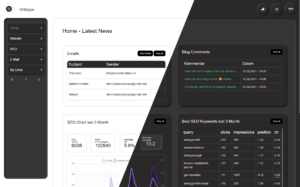Basic rules for SEO

SEO (search engine optimization) is a huge subject area that cannot be covered in one blog post alone. What we can cover here, however, is a small subset of the whole topic. In this blog post, we will cover the topic of on-site SEO optimization.
This covers the way we should create texts in blog posts and static pages. Other topics, such as technical SEO and off-site SEO would go beyond the scope here.
Search Engine Optimization
In order to appear as high as possible on Google with one’s content pages and posts, there are about 200 different factors, which are constantly adapting and are only really known to Google itself. One must always keep in mind that all texts on the website have to be read and understood by an algorithm.
Since no one knows the exact functioning of the algorithm of Google and this is and will remain the trade secret of Google, we have to be satisfied with empirical values.
The empirical values, which we could collect with our customers, show us that the following things are important and must be considered.
On-Site-SEO – Optimize texts for Google
Basically, you should have enough text on your pages. This includes content pages and blog posts. Google once gave a rule of thumb of at least 300 words per post, which we can confirm.
Furthermore, it is of great advantage to create a table of contents to make longer posts easier and more readable.
Optimize SEO – Create clear texts
As in a Word document, you should divide your text into meaningful topics and insert them with the respective titles in the appropriate HTML tags.
(<h1></h1>, <h2></h2> to <h6> </h6>)
For ease of mobile use, it is important that your paragraphs are not all that long. A paragraph of 10 lines on a computer is a veritable wasteland of lead on a smartphone. You should avoid this if you have a lot of mobile users on your website, which is the case with almost all websites today (70% of all internet traffic comes from smartphones).
Wp Headless with decoupled admin panel
It is possible to combine a WP-Headless installation with an external admin panel. For more complex website constructs, this can be very helpful as you can have the advantage of a modern frontend as well as a modern admin panel without having to build your WordPress website from scratch. Step-by-step renewal of a WordPress website…
Read MoreContent marketing and content upgrades in detail
Content upgrades – active monetisationA widespread type of active monetisation is to provide so-called content upgrades for blog posts. These are usually in the form of audio books or videos on a certain topic. Monetisation with content upgradesBy the way, this works the same way in reverse. If you provide a podcast or video series …
Read MoreSeo & Workflow focused WordPress Admin alternative Orbitype
The WordPress admin area is great for creating a website. Many plugins are installed to the creation are unavoidable. This becomes a problem as soon as the creation of the website is finished. Too many plugins have pop-ups and makes the whole user interface (WP-ADMIN) very confusing for everyday adjustments. Orbitype provides a pleasant working…
Read MorePaid advertising (social media/search engines)
Paid online advertising – pull advertising and push advertising Billboard advertising, as it has existed for ages, would be called…
Read MoreActive Monetisation Part 1/2
By “active monetization” of a website, we at Webentertainer understand that the website visitor must clearly decide to buy a…
Read MoreResponsive design to protect against mobile-first conversion
Mobile-First Index from Google In September 2020, the switch to Google’s Mobile-First Index took place. This means that websites will…
Read MorePlans & pricing
Stay cool, we have a 48-hour money back guarantee!






